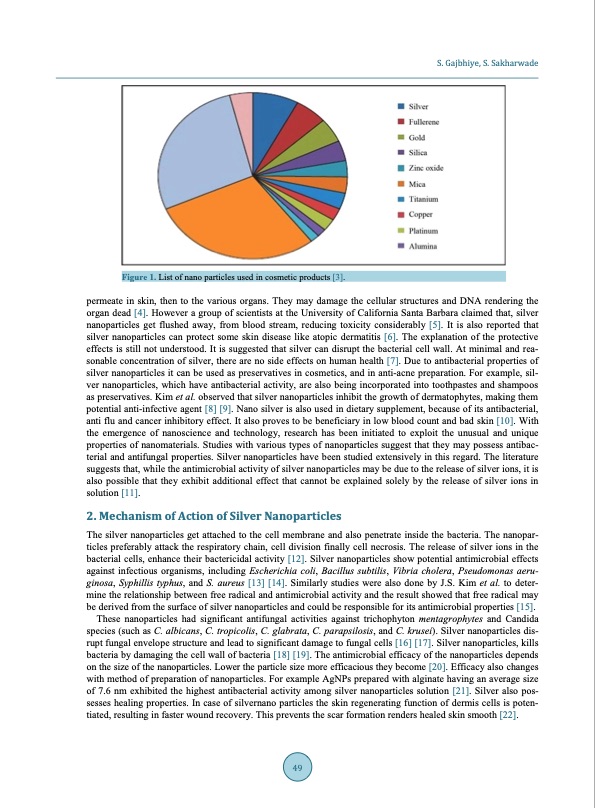
PDF Publication Title:
Text from PDF Page: 002
Figure 1. List of nano particles used in cosmetic products [3]. permeate in skin, then to the various organs. They may damage the cellular structures and DNA rendering the organ dead [4]. However a group of scientists at the University of California Santa Barbara claimed that, silver nanoparticles get flushed away, from blood stream, reducing toxicity considerably [5]. It is also reported that silver nanoparticles can protect some skin disease like atopic dermatitis [6]. The explanation of the protective effects is still not understood. It is suggested that silver can disrupt the bacterial cell wall. At minimal and rea- sonable concentration of silver, there are no side effects on human health [7]. Due to antibacterial properties of silver nanoparticles it can be used as preservatives in cosmetics, and in anti-acne preparation. For example, sil- ver nanoparticles, which have antibacterial activity, are also being incorporated into toothpastes and shampoos as preservatives. Kim et al. observed that silver nanoparticles inhibit the growth of dermatophytes, making them potential anti-infective agent [8] [9]. Nano silver is also used in dietary supplement, because of its antibacterial, anti flu and cancer inhibitory effect. It also proves to be beneficiary in low blood count and bad skin [10]. With the emergence of nanoscience and technology, research has been initiated to exploit the unusual and unique properties of nanomaterials. Studies with various types of nanoparticles suggest that they may possess antibac- terial and antifungal properties. Silver nanoparticles have been studied extensively in this regard. The literature suggests that, while the antimicrobial activity of silver nanoparticles may be due to the release of silver ions, it is also possible that they exhibit additional effect that cannot be explained solely by the release of silver ions in solution [11]. 2. Mechanism of Action of Silver Nanoparticles The silver nanoparticles get attached to the cell membrane and also penetrate inside the bacteria. The nanopar- ticles preferably attack the respiratory chain, cell division finally cell necrosis. The release of silver ions in the bacterial cells, enhance their bactericidal activity [12]. Silver nanoparticles show potential antimicrobial effects against infectious organisms, including Escherichia coli, Bacillus subtilis, Vibria cholera, Pseudomonas aeru- ginosa, Syphillis typhus, and S. aureus [13] [14]. Similarly studies were also done by J.S. Kim et al. to deter- mine the relationship between free radical and antimicrobial activity and the result showed that free radical may be derived from the surface of silver nanoparticles and could be responsible for its antimicrobial properties [15]. These nanoparticles had significant antifungal activities against trichophyton mentagrophytes and Candida species (such as C. albicans, C. tropicolis, C. glabrata, C. parapsilosis, and C. krusei). Silver nanoparticles dis- rupt fungal envelope structure and lead to significant damage to fungal cells [16] [17]. Silver nanoparticles, kills bacteria by damaging the cell wall of bacteria [18] [19]. The antimicrobial efficacy of the nanoparticles depends on the size of the nanoparticles. Lower the particle size more efficacious they become [20]. Efficacy also changes with method of preparation of nanoparticles. For example AgNPs prepared with alginate having an average size of 7.6 nm exhibited the highest antibacterial activity among silver nanoparticles solution [21]. Silver also pos- sesses healing properties. In case of silvernano particles the skin regenerating function of dermis cells is poten- tiated, resulting in faster wound recovery. This prevents the scar formation renders healed skin smooth [22]. S. Gajbhiye, S. Sakharwade 49PDF Image | Silver Nanoparticles in Cosmetics 2016

PDF Search Title:
Silver Nanoparticles in Cosmetics 2016Original File Name Searched:
Silver_Nanoparticles_in_Cosmetics.pdfDIY PDF Search: Google It | Yahoo | Bing
Turbine and System Plans CAD CAM: Special for this month, any plans are $10,000 for complete Cad/Cam blueprints. License is for one build. Try before you buy a production license. More Info
Waste Heat Power Technology: Organic Rankine Cycle uses waste heat to make electricity, shaft horsepower and cooling. More Info
All Turbine and System Products: Infinity Turbine ORD systems, turbine generator sets, build plans and more to use your waste heat from 30C to 100C. More Info
CO2 Phase Change Demonstrator: CO2 goes supercritical at 30 C. This is a experimental platform which you can use to demonstrate phase change with low heat. Includes integration area for small CO2 turbine, static generator, and more. This can also be used for a GTL Gas to Liquids experimental platform. More Info
Introducing the Infinity Turbine Products Infinity Turbine develops and builds systems for making power from waste heat. It also is working on innovative strategies for storing, making, and deploying energy. More Info
Need Strategy? Use our Consulting and analyst services Infinity Turbine LLC is pleased to announce its consulting and analyst services. We have worked in the renewable energy industry as a researcher, developing sales and markets, along with may inventions and innovations. More Info
Made in USA with Global Energy Millennial Web Engine These pages were made with the Global Energy Web PDF Engine using Filemaker (Claris) software.
Infinity Turbine Developing Spinning Disc Reactor SDR or Spinning Disc Reactors reduce processing time for liquid production of Silver Nanoparticles.
| CONTACT TEL: 608-238-6001 Email: greg@infinityturbine.com | RSS | AMP |